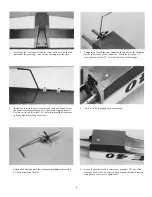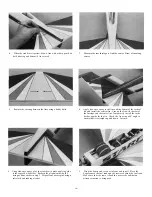
STARTING THE ENGINE
ENGINE MAINTENANCE
Always check the engine mounting bolts, muffler, glow plug, propeller
and spinner, etc , before attempting to start the engine Check for
loose bolts, nuts or screws which may come off when the engine is
running and cause serious damage Always check the area in which
you w i l l be flying or just running the engine Check for possible
hazards, such as loose rags, rocks, tools, etc., lying on the ground which
may get caught in the prop
If you intend on starting the engine by hand flipping the prop, always
use a chicken stick, and be sure to check the position of the prop It is
most comfortable when it is at the 2 o clock position when starting the
compression stroke When you are using an electric 12V starter, try to
p o s i t i o n the prop p a r e l l e l to the w i n g at the b e g i n n i n g of the
compression stroke
ENGINE BREAK-IN AND STARTING
Most manufacturers recommend that the engine be broken-in on a test
s t a n d We also r e c o m m e n d t h a t t h i s be d o n e a c c o r d i n g to
manufacturers instructions If a test stand is unavailable the engine
may be broken-in on the airplane Breaking-in the engine allows the
parts to 'seat to each other Proper break-in and maintenance will
help ensure dependable trouble-free operation and longer l i f e of the
engine.
1. Use a filter on the carburetor line
2. Fill the f u e l tank When the tank is full, the fuel will come out
the muffler
3. Follow you manufacturer's instructions according to needle valve
settings.
4. Turn the radio system on and open the throttle to full open.
Place your finger over the air intake on the carburetor while
turning the prop counter-clockwise a few times Watch the fuel
line If no fuel is reaching the carburetor, recheck the fuel line
plumbing
5. Reduce the throttle to 1/4 or 1/2 throttle for starting.
6. Using a starting stick (chicken stick) and holding the fuselage
firmly, quickly flip the prop in the counter-clockwise direction
(Do not attach the glow plug clip in this step) This will
prevent the engine from being flooded and w i l l make starting
much easier Do not use bare hands/fingers for starting, as the
kick back from a model engine can be strong enough to cause
severe injury.
7. Attach the glow plug clip at this time.
8. With quick flipping movements, flip the prop in the counter-
clockwise direction If the engine does not try to start in the
first few tries, double check your procedure and keep trying
9 Once the engine has started, listen carefully to the sound of the
engine The sound of the engine will tell you how the engine is
running, if you know what to listen for A lower-tone, popping
sound is the sound of a rich running engine As you turn the
needle valve in, the popping sounds should decrease and the
pitch of the engine should rise The optimum needle valve
setting will depend on your engine and current weather
conditions Again check with the manufacturer's
recommendations for engine break-in procedures and valve
settings
10. As a guideline, always run a new engine slightly rich This will
allow the engine extra break-in time and will help ensure future
dependability
11. If you continue to have problems with the performance of
starting of your engine, refer to the engine trouble shooting
guide as shown below
ENGINE TROUBLESHOOTING GUIDE
SYMPTOM
The engine does not start.
The propeller is difficult to
rotate.
The engine fires but does not
start.
The engine starts but does
not sound or run well.
POSSIBLE CAUSE
Glow plug battery is making poor contact.
Battery is dead or has a very low voltage.
Bad glow plug (burned out or deteriorated filament).
Improper air/fuel mixture intake.
Engine is flooded with fuel.
Engine may be flooded.
Fuel is not reaching the carburetor.
Improper break-in procedures.
Loose plug or bad plug.
SOLUTION
Check to see if the battery is wired correctly and to see
if the clip is making good contact with the plug.
Replace or recharge the battery or glo-starter and
check to make sure the battery can glow the plug red
hot prior to starting.
Replace the glow plug.
Prime the engine through the carburetor air intake.
Close the needle valve completely and try to start the
engine. It should start and then quickly stop. Reset
the needle valve and try again.
Remove the glow plug and rotate the engine until only
a mist of fuel remains in the cylinder. Replace the
plug and continue.
Check the level of fuel in the tank. Recheck fuel.
Open the needle valve a half turn or so and continue.
Check the break-in procedure and repeat.
Replace the plug and/or tighten the old plug.
22.

















